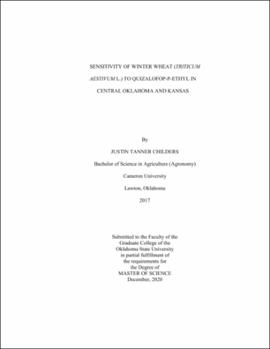| dc.description.abstract | CoAXium® Wheat Production System, developed by Colorado Wheat Research Foundation, Albaugh Chemical, and Limagrain, is a new herbicide tolerant wheat that allows for the use of Aggressor^TM herbicide [active ingredient: quizalofop-p-ethyl (quizalofop)] for control of grassy weeds. An increase in applications of quizalofop may increase the likelihood of physical drift and/or tank contamination to nearby sensitive plants, including wheat that is not tolerant to quizalofop. To further evaluate this challenge, a trial was conducted at four locations in the central Great Plains, during the 2018-2019 and 2019-2020 growing seasons. Five quizalofop rates were used: 1X (92 g ai ha-1), 1/10X, 1/50X, 1/100X, and 1/200X, along with two different application timings: 2- 3-leaf (fall) and 3- 4-tiller (spring). Visual injury was evaluated every two weeks throughout the growing season, along with the collection of end-of-season biomass, harvest index, and grain yield. For yield, herbicide rate by application timing interaction was significant for half of the site years. At the other four site years, a herbicide rate main effect was observed. For the interaction, regardless of application timing, the field-use rate 1X resulted in complete crop loss or near crop loss. For the 1/10X rate with the fall application, yield loss ranged from 0 to 39% whereas with the spring application, loss ranged from 80 to 100%. No significant yield reduction was observed following the three lowest rates, except for Stillwater 2019 and 2020, then Perkins in 2019. At Stillwater there was an 11% reduction in yield at the 1/200X rate in 2019, and 20% yield reduction at the 1/50X rate in 2020. Perkins 2019 also had an 8% yield reduction followed the 1/50X rate When rate was a significant main effect, all 1/10X applications led to 86 to 100% yield loss. There was no significant visual injury or yield loss with the three lowest rates with the exclusions above. The environment had a substantial impact on wheat response with the 1/10X rate. Minimal response was most likely when it was cold and dry before and after application because wheat plants were not actively growing, thus not translocating the herbicide effectively. | |
